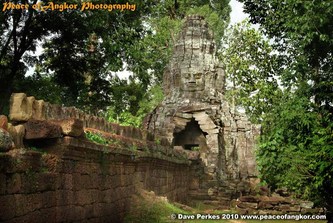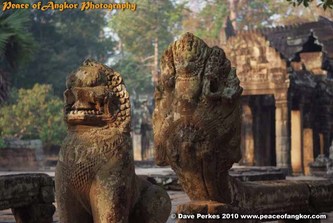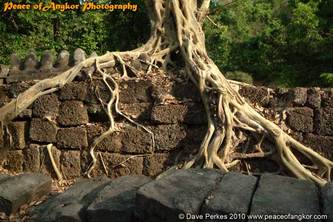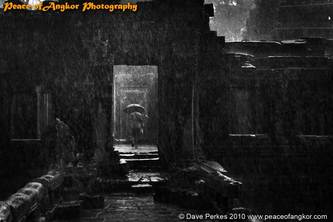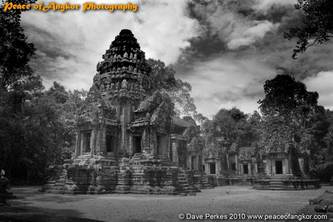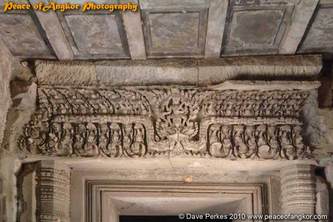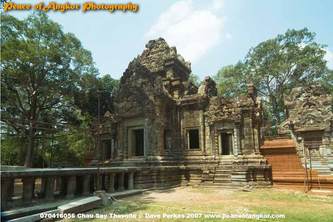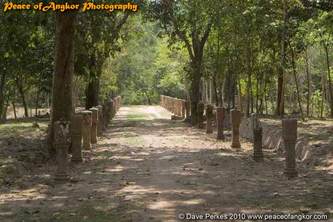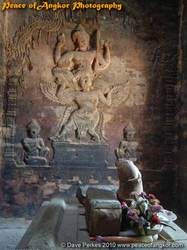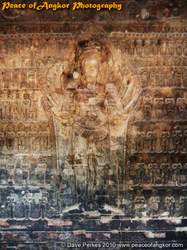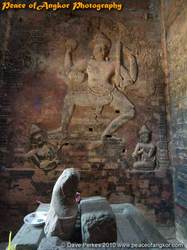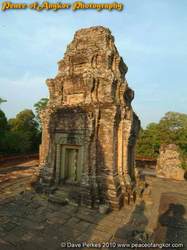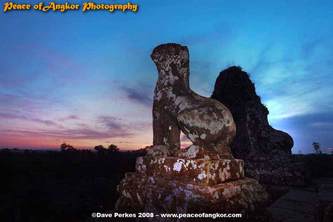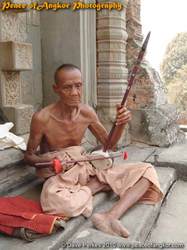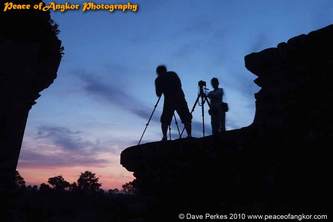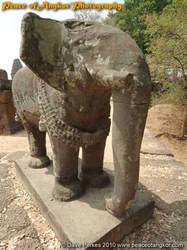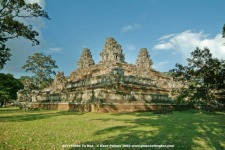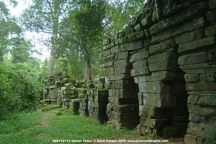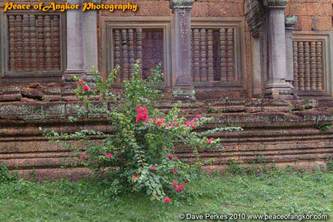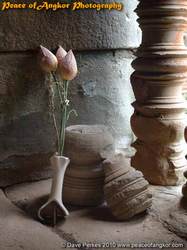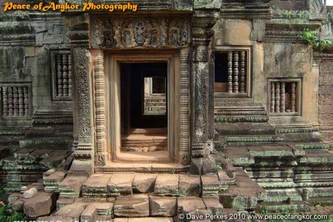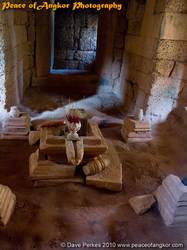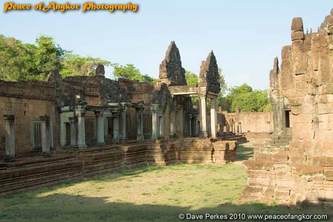PEACE OF ANGKOR PHOTOGRAPHY
THE EASTERN TEMPLES and others around the Grand Circuit

Ta Keo
The temples of the Grand Circuit are to the North and east of of Angkor Thom. The circuit was laid out by the French at the beginning of the 20th Century. The Circuit includes some of the most attractive sites of Angkor; including Preah Khan; East Mebon , Pre Rup, and Ta Som I have included Bantey Kdei and to the east, Banteay Samre.
Much of the area which visitors see, is on or around the immense Eastern Baray Reservoir. Extending for 7.5 kms by 1.8kms, it was built by constructing earth banks and was filled by rainwater. The East Baray eventually dried up; so when the French devised the Grand Circuit they cut through the Banks; which can be seen best Near Banteay Samre and on the road north of Pre Dak Village to the east of the East Mebon.
Much of the area which visitors see, is on or around the immense Eastern Baray Reservoir. Extending for 7.5 kms by 1.8kms, it was built by constructing earth banks and was filled by rainwater. The East Baray eventually dried up; so when the French devised the Grand Circuit they cut through the Banks; which can be seen best Near Banteay Samre and on the road north of Pre Dak Village to the east of the East Mebon.
You are in Angkor Temples - Angkor Wat - Angkor Thom - Bayon - Ta Prohm - Preah Khan - Eastern Temples
BANTEAY KDEI The Citadel of the Cells
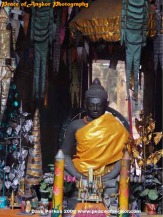
Buddha at Banteay Kdei
Banteay Kdei is a 12th Bayon Style monastic complex which has a lot of the atmosphere of its famous neighbour Ta Prohm but few of the crowds. Adjoining Srah Srang Reservoir, Banteay Kdei is best approached from the east in the morning. The four faced Bayon style gate glows in the sun with dappled light from the overhanging trees. You enter via a causeway which leads to a low platform; Terrace (or Hall) of The Dancers. The complex inner structures are in a partially ruined state.
The East Gopura (entrance) to the third enclosure of Banteay Kdei has a statue of Buddha sitting in meditation with a wooden Wheel of Life behind it. Beyond here a passage traverses the entire complex to the small centre shrine. Some of the complex inner structures are in a partial ruined state. The central towers have been supported by wires to stabilize them. To the west a massive buttressed tree is reflected in the moat which is usually full at the end of the rainy season (August to December).
The East Gopura (entrance) to the third enclosure of Banteay Kdei has a statue of Buddha sitting in meditation with a wooden Wheel of Life behind it. Beyond here a passage traverses the entire complex to the small centre shrine. Some of the complex inner structures are in a partial ruined state. The central towers have been supported by wires to stabilize them. To the west a massive buttressed tree is reflected in the moat which is usually full at the end of the rainy season (August to December).
Thommanon and Chau Say Thevoda

Thommanon
Leaving Angkor Thom by the Victory Gate there are two temples to north and south of the road; Thommanon and Chau Say Thevoda.
Thommanon to the north, is a minor jewel, being beautifully restored in the 1960s. The small temple buildings are in the style of Angkor Wat. Thommanon has reproductions of the original wood ceilings in the central tower. These are unique in Angkor. There is a finely carved lintel with 4 armed Vishnu above an internal doorway.
Chau Say Thevoda is very similar in style and has a causeway lines with lantern towers, leading to the Siem Reap River.
Thommanon to the north, is a minor jewel, being beautifully restored in the 1960s. The small temple buildings are in the style of Angkor Wat. Thommanon has reproductions of the original wood ceilings in the central tower. These are unique in Angkor. There is a finely carved lintel with 4 armed Vishnu above an internal doorway.
Chau Say Thevoda is very similar in style and has a causeway lines with lantern towers, leading to the Siem Reap River.
Prasat Kravan
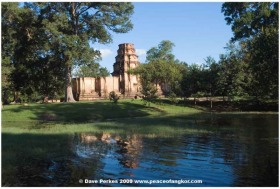
Prasat Kravan
To the east of the Small Circuit; you can see a 10th century brick temple of Prasat Kravan. The five small towers are often ignored in favour of the larger offerings round Angkor. The detour is worthwhile to see the brick relief's, which are unique in Angkor.
Prasat Kravan, like most of the earliest temples, was constructed of bricks bonded with a mortar made from vegetable glue and covered with stucco. It is remarkable how this method of construction survived so well over the centuries.
There are areas of original bricks still in place; however the base, adjoining platforms and much of the exterior of the towers, were rebuilt in the last century using new bricks. The chimney like towers; are open to the sky. Canopies would have been suspended from brick hooks, to protect the statuary below.
Prasat Kravan, like most of the earliest temples, was constructed of bricks bonded with a mortar made from vegetable glue and covered with stucco. It is remarkable how this method of construction survived so well over the centuries.
There are areas of original bricks still in place; however the base, adjoining platforms and much of the exterior of the towers, were rebuilt in the last century using new bricks. The chimney like towers; are open to the sky. Canopies would have been suspended from brick hooks, to protect the statuary below.
The Triptych of Vishnu showing Vishnu on a Garuda, Vishnu with 8 arms surrounded by human figures and Vishnu Spanning the Universe
Pre Rup and The East Mebon
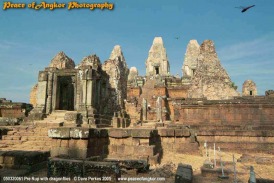
Pre Rup Central Towers
Situated in the centre of the now dry Eastern Baray; the 10th century brick temple of East Mebon has a classic pyramid form with five towers. The temple features stone elephants on the corners of the second level. East Mebon had a decorative covering of Stucco, over the centuries the plaster washed away leaving the underlying bricks exposed. You will see regular holes in bricks which we re likely to have been used to key in the plaster or attach cladding.
Pre Rup is virtually identical to the East Mebon with five brick towers in a quincunx formation. The name Pre Rup refers to the turning of the body to ash after cremation.
Pre Rup is becoming a popular sunset and sunrise view point due to is open aspect with clear views from the upper levels which are accessed by extremely steep steps.
Pre Rup is virtually identical to the East Mebon with five brick towers in a quincunx formation. The name Pre Rup refers to the turning of the body to ash after cremation.
Pre Rup is becoming a popular sunset and sunrise view point due to is open aspect with clear views from the upper levels which are accessed by extremely steep steps.
Banteay Samre

Banteay Samre
Situated to the East of the old Eastern Baray reservoir; Banteay Samre is a 11th Century temple in the style of Angkor Wat. It was conceived as a Buddhist temple but had later Hindu iconography added up to the time of Jayavarman VII.
A feature of the building is the high red laterite double walls. Inside, the sanctuary has a single lotus flower tower, shrines and libraries which are a delight to explore. There is a well preserved Naga causeway and cruciform terrace similar to Angkor Wat to the east.
The drive out there is an attractive one and the temple is far enough away from the main temples not to get too crowded.
A feature of the building is the high red laterite double walls. Inside, the sanctuary has a single lotus flower tower, shrines and libraries which are a delight to explore. There is a well preserved Naga causeway and cruciform terrace similar to Angkor Wat to the east.
The drive out there is an attractive one and the temple is far enough away from the main temples not to get too crowded.

For more information of our Day Tours to Angkor

